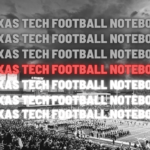 Right on Target: Whoever is playing quarterback is going to have some big targets. Three receivers who are at least 6’4″ should certainly help that vertical passing game. Texas Tech was really unable to employ that vertical game this year, namely because the biggest receiver that Texas Tech started was 6’1″, either Reginald Davis or Devin Lauderdale. Texas Tech has upgraded on size immediately, with Derrick Willies and in the pipe, T.J. Vasher and Antoine Cox-Wesley should provide some terrific size for years to come. And that’s the difference, maybe, between these guys and Donta Thompson, who is supposed to project as a potential tight end, depending on the pounds he is able to add. Add to a healthy Dylan Cantrell, who stands at 6’3″ and you could have a significantly different looking lineup for Texas Tech on the outside. And this doesn’t mean that guys like Quan Shorts or Tony Brown doesn’t have a place, that it’ sall about size, but it certainly gives Texas Tech some additional options. Having very little height is problematic, having options should alleviate some of those problems.
Right on Target: Whoever is playing quarterback is going to have some big targets. Three receivers who are at least 6’4″ should certainly help that vertical passing game. Texas Tech was really unable to employ that vertical game this year, namely because the biggest receiver that Texas Tech started was 6’1″, either Reginald Davis or Devin Lauderdale. Texas Tech has upgraded on size immediately, with Derrick Willies and in the pipe, T.J. Vasher and Antoine Cox-Wesley should provide some terrific size for years to come. And that’s the difference, maybe, between these guys and Donta Thompson, who is supposed to project as a potential tight end, depending on the pounds he is able to add. Add to a healthy Dylan Cantrell, who stands at 6’3″ and you could have a significantly different looking lineup for Texas Tech on the outside. And this doesn’t mean that guys like Quan Shorts or Tony Brown doesn’t have a place, that it’ sall about size, but it certainly gives Texas Tech some additional options. Having very little height is problematic, having options should alleviate some of those problems.
 Lights, Camera, Action: The stars of this class is the defensive line. The much maligned group of players that have had little to no respect in what seems like way too long. Four defensive tackles and three defensive ends, all with legitimate size and frames to make sure change the direction of the defense. I personally think that Nick McCann is a starter waiting to happen, but you can love Big Joe Wallace as well. McCann seems to have that body he already needs, with what seems to be a lot less body fat and more strength. Wallace though was ridiculously productive in a highly competitive area in Dallas. I thought it was interesting that Ivory Jackson, at least according to Kingsbury, said that Jackson currently weighs 240 or so as he’s running track, but he will play at defensive tackle. It would ridiculously nice to have Jackson to be a tackle or an end. He has the frame of a defensive end because of his height. Plus, Mychealon Thomas, the JUCO who only has two years to play, we hope can be part of the rotation.
Lights, Camera, Action: The stars of this class is the defensive line. The much maligned group of players that have had little to no respect in what seems like way too long. Four defensive tackles and three defensive ends, all with legitimate size and frames to make sure change the direction of the defense. I personally think that Nick McCann is a starter waiting to happen, but you can love Big Joe Wallace as well. McCann seems to have that body he already needs, with what seems to be a lot less body fat and more strength. Wallace though was ridiculously productive in a highly competitive area in Dallas. I thought it was interesting that Ivory Jackson, at least according to Kingsbury, said that Jackson currently weighs 240 or so as he’s running track, but he will play at defensive tackle. It would ridiculously nice to have Jackson to be a tackle or an end. He has the frame of a defensive end because of his height. Plus, Mychealon Thomas, the JUCO who only has two years to play, we hope can be part of the rotation.
Then add in those defensive ends that have legitimate size, such as Noah Jones and Clarence Henderson, as well as MIller and I like my odds for this group to produce a rotation of defensive linemen. There may not be a star, but there is a chance the collective group can be a significant upgrade and the star of the class.
 Bolt: Maybe the one thing that this class is missing, that was in previous classes is that flat-out quickness and speed. I don’t think this is a bad thing. Sometimes you trade-off size for speed and I definitely think that the staff did that at receiver and in the secondary. Regardless of what the 40-yard dash times state, it’s uncommon that a 6’4″ receiver is as fast as a 6’0″ receiver (again, you’ll have to ignore those fake 40-yard dash times) or that a 5’9″ defensive back is quicker right out of the gate than a 6’1″ cornerback. But size can make up for speed and I don’t think that any of the defensive backs or receivers are bad athletes, just maybe not as fast. It’s definitely going to be interesting to see how that plays out over the course of their careers. And maybe this is about having a good mix of players, although from a defensive secondary standpoint it appears that Gibbs wants taller players rather than those of the 5’9″ variety.
Bolt: Maybe the one thing that this class is missing, that was in previous classes is that flat-out quickness and speed. I don’t think this is a bad thing. Sometimes you trade-off size for speed and I definitely think that the staff did that at receiver and in the secondary. Regardless of what the 40-yard dash times state, it’s uncommon that a 6’4″ receiver is as fast as a 6’0″ receiver (again, you’ll have to ignore those fake 40-yard dash times) or that a 5’9″ defensive back is quicker right out of the gate than a 6’1″ cornerback. But size can make up for speed and I don’t think that any of the defensive backs or receivers are bad athletes, just maybe not as fast. It’s definitely going to be interesting to see how that plays out over the course of their careers. And maybe this is about having a good mix of players, although from a defensive secondary standpoint it appears that Gibbs wants taller players rather than those of the 5’9″ variety.
The two players that had that real quickness and speed is probably Bryson Denley and De’Quan Bowman. A torn ACL at the end of the year ended up meaning that Denley would greyshirt, which means that he won’t be arriving on campus this fall, but in the spring and it most likely opens up another spot in case there is a transfer. Denley was supposed to have significant speed, running a 10.4 in the 100m dash before his injury and that sort of inside speed. Bowman should immediately step in and compete at an inside receiver position and being here this fall, should help that progress.
 The Light Comes On: It’s amazing what talented linebackers should be able to do. Kingsbury has essentially recruited two linebackers the past two years and it’s no surprise that they were or could have been starting by the end of the year. The 2013 class, Kingsbury’s first class, had plenty of linebackers, but they’ve been passed over on the depth chart in favor of Dakota Allen and D’Vonta Hinton. I wonder how much the current crop of linebackers will be able to make waves. The interesting thing here is that three of the four are a bit undersized, but have good sized frames to add some weight, while the finished product, Jordyn Brooks, looks like he’s ready to play today. Being 230 pounds certainly helps that and with Johnathan Picone already on campus, Brooks will most likely have some serious competition next year. And Kevin Moore is most likely to follow in the foot-steps of someone like Jamile Johnson, a hard-hitting player that could play near the line of scrimmage or as a safety. I think David Gibbs all but acknowledged that Moore would start at safety and potentially move to linebacker. And the most likely scenario with Braden Stringer, even though he is most likely going to be ready by fall practice, is a redshirt. There’s only so many spots available.
The Light Comes On: It’s amazing what talented linebackers should be able to do. Kingsbury has essentially recruited two linebackers the past two years and it’s no surprise that they were or could have been starting by the end of the year. The 2013 class, Kingsbury’s first class, had plenty of linebackers, but they’ve been passed over on the depth chart in favor of Dakota Allen and D’Vonta Hinton. I wonder how much the current crop of linebackers will be able to make waves. The interesting thing here is that three of the four are a bit undersized, but have good sized frames to add some weight, while the finished product, Jordyn Brooks, looks like he’s ready to play today. Being 230 pounds certainly helps that and with Johnathan Picone already on campus, Brooks will most likely have some serious competition next year. And Kevin Moore is most likely to follow in the foot-steps of someone like Jamile Johnson, a hard-hitting player that could play near the line of scrimmage or as a safety. I think David Gibbs all but acknowledged that Moore would start at safety and potentially move to linebacker. And the most likely scenario with Braden Stringer, even though he is most likely going to be ready by fall practice, is a redshirt. There’s only so many spots available.
The idea here is that it seemed like the 2013 class was a tough one to fill and maybe there was a part of the situation where the staff recruited bodies to fill spots, but with this class, there was specific intent on the type of player. Still, it seemed like it took way too long to get this done, start recruiting some players and depth at a position of need. I would guess that this is addressed each year because there’s just no other way around it.
 Key to the Class: I think I’d have to go with two commits as the keys for the class. Not because of their play on the field, which was exemplary, but because of the way that they apparently communicated with their teammates: Jett Duffey and Houston Miller. Duffey, is by all accounts, a terrifically friendly person and although not incredibly vocal, he seemed like he is really well liked and he is, quite frankly, very likable as just an outsider. Regardless of his personality, Texas Tech needed to get rid of aftertaste last year and Duffey is really the best candidate. Duffey and Miller, in a sense, epitomize what I think of underrated players, they’re not perfect specimens, but they sure as heck put up some terrific stats on highly competitive teams.
Key to the Class: I think I’d have to go with two commits as the keys for the class. Not because of their play on the field, which was exemplary, but because of the way that they apparently communicated with their teammates: Jett Duffey and Houston Miller. Duffey, is by all accounts, a terrifically friendly person and although not incredibly vocal, he seemed like he is really well liked and he is, quite frankly, very likable as just an outsider. Regardless of his personality, Texas Tech needed to get rid of aftertaste last year and Duffey is really the best candidate. Duffey and Miller, in a sense, epitomize what I think of underrated players, they’re not perfect specimens, but they sure as heck put up some terrific stats on highly competitive teams.
You saw his highlights, but get to know #TexasTech QB signee Jett Duffey a little better. #WreckEm16https://t.co/NSIP7Jtih7
— Texas Tech Red Raiders (@TechAthletics) February 3, 2016
With Houston Miller, he seems like a very vocal leader and a binder more than anything else. Both Miller and Duffey are really probably underrated a bit (we can say that about lots of guys though), whether it be their size or speed or some other tangible that’s docked them a star or points or a grade or whatever. Still trying to wrap my head around the idea that Miller was a two-star on Rivals just a few weeks ago before he was bumped up.
 Finding Their Way: Kingsbury said the word “evaluation” nine times during his post-signing day press conference. Whether it was him talking about Lee Hays doing his own evaluations, or the staff catching up any new coaches as to how they want to evaluate players or David Gibbs making his own evaluations about what he wants in terms of players. This should be the nerve-wrecking portion of recruiting because this class doesn’t line up with what the recruiting services think about your class. Kingsbury and the coaches have essentially made their own decisions about players, regardless of recruiting rankings.
Finding Their Way: Kingsbury said the word “evaluation” nine times during his post-signing day press conference. Whether it was him talking about Lee Hays doing his own evaluations, or the staff catching up any new coaches as to how they want to evaluate players or David Gibbs making his own evaluations about what he wants in terms of players. This should be the nerve-wrecking portion of recruiting because this class doesn’t line up with what the recruiting services think about your class. Kingsbury and the coaches have essentially made their own decisions about players, regardless of recruiting rankings.
This concept works if you know how to evaluate players and as of right now, I think we’re still a bit in the dark about whether or not Kingsbury knows how to evaluate players. There are certain aspects, where we are completely sure about the evaluation process, i.e. Breiden Fehoko, Patrick Mahomes or Jah’Shawn Johnson or Dakota Allen, but for the most part, we haven’t really seen Kingsbury’s players. TCU head coach Gary Patterson is the guy that knows how to evaluate players. He’s proven that he can take an athlete and project that athlete into a player that either fits into his system or is just flipping good. Seriously, Patterson is a genius when it comes to this talent and Kingsbury knows that:
Yeah, it is tough. You’ve got to be good at your evaluations because a lot of those kids want the ball in their hands, and it’s part of playing the game. I think when you see a certain skill set, if he can run fast, he’s physical, he can jump, I think the good coaches, the good evaluators, can project him at a different position. And there’s a team like TCU, Coach Patterson has done that for a lot of years and been very successful doing that.
There’s part of me that believes that Kingsbury didn’t have much, if any say, when it came to the defensive staff evaluations. The recruitment and signing of a handful of JUCO defensive linemen was a band-aid for a quick fix, but being that Kingsbury had a very short window to put a class together, you can almost forgive that.
But last year and this year’s classes should hopefully be about a system that Kingsbury has in place to properly evaluate players:
I think we’re getting closer where we want to be. With the coaching changes, you’re always starting over each year when you have coaching changes and when it comes to areas, and a guy is learning how we evaluate our process, things of that nature. But I think we’re getting streamlined, getting more efficient. I felt like we did a great job recruiting this year.
 Picture Perfect: The 2016 Texas Tech recruiting class really does represent Texas Tech as a whole on a lot of levels. Not a ton of stars. It’s got a lot of grit (Or at least, this is what we tend to think, i.e. folks tend to say, “I’ll take players that want to be here over any stars any day of the week.”) I don’t know if it is irony or just the way it is supposed to be. Sometimes I wonder what the ceiling is in terms of Texas Tech’s recruiting class. Texas ended up pulling off a fantastic recruiting class in terms of the recruiting services evaluation, and make no mistake, generally speaking recruiting services are correct more than not. There are always exceptions to those rules, but Alabama has had the #1 class for a handful of years, meanwhile, both Baylor and TCU have been about where Texas Tech currently sits, around 40th or so, and have had double-digit wins for two years in a row. Again, these things aren’t totally predictive, but recruiting rankings are solid indicators. And Oklahoma recruited nationally very well this year. Baylor has added a ton of talent to their class and is maybe the best they have recruited in recent memory. Same thing for TCU.
Picture Perfect: The 2016 Texas Tech recruiting class really does represent Texas Tech as a whole on a lot of levels. Not a ton of stars. It’s got a lot of grit (Or at least, this is what we tend to think, i.e. folks tend to say, “I’ll take players that want to be here over any stars any day of the week.”) I don’t know if it is irony or just the way it is supposed to be. Sometimes I wonder what the ceiling is in terms of Texas Tech’s recruiting class. Texas ended up pulling off a fantastic recruiting class in terms of the recruiting services evaluation, and make no mistake, generally speaking recruiting services are correct more than not. There are always exceptions to those rules, but Alabama has had the #1 class for a handful of years, meanwhile, both Baylor and TCU have been about where Texas Tech currently sits, around 40th or so, and have had double-digit wins for two years in a row. Again, these things aren’t totally predictive, but recruiting rankings are solid indicators. And Oklahoma recruited nationally very well this year. Baylor has added a ton of talent to their class and is maybe the best they have recruited in recent memory. Same thing for TCU.










